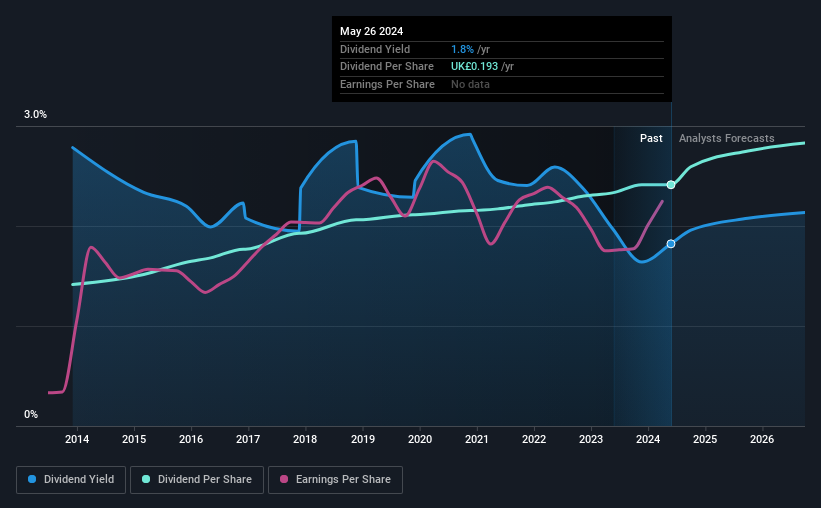The Sage Group plc (LON:SGE) Is About To Go Ex-Dividend, And It Pays A 1.8% Yield
Readers hoping to buy The Sage Group plc (LON:SGE) for its dividend will need to make their move shortly, as the stock is about to trade ex-dividend. The ex-dividend date is one business day before the record date, which is the cut-off date for shareholders to be present on the company's books to be eligible for a dividend payment. The ex-dividend date is important because any transaction on a stock needs to have been settled before the record date in order to be eligible for a dividend. Thus, you can purchase Sage Group's shares before the 30th of May in order to receive the dividend, which the company will pay on the 28th of June.
The company's next dividend payment will be UK£0.0695 per share, and in the last 12 months, the company paid a total of UK£0.19 per share. Last year's total dividend payments show that Sage Group has a trailing yield of 1.8% on the current share price of UK£10.595. We love seeing companies pay a dividend, but it's also important to be sure that laying the golden eggs isn't going to kill our golden goose! So we need to check whether the dividend payments are covered, and if earnings are growing.
See our latest analysis for Sage Group
Dividends are typically paid out of company income, so if a company pays out more than it earned, its dividend is usually at a higher risk of being cut. Its dividend payout ratio is 75% of profit, which means the company is paying out a majority of its earnings. The relatively limited profit reinvestment could slow the rate of future earnings growth. We'd be concerned if earnings began to decline. Yet cash flows are even more important than profits for assessing a dividend, so we need to see if the company generated enough cash to pay its distribution. Dividends consumed 51% of the company's free cash flow last year, which is within a normal range for most dividend-paying organisations.
It's positive to see that Sage Group's dividend is covered by both profits and cash flow, since this is generally a sign that the dividend is sustainable, and a lower payout ratio usually suggests a greater margin of safety before the dividend gets cut.
Click here to see the company's payout ratio, plus analyst estimates of its future dividends.
Have Earnings And Dividends Been Growing?
Companies that aren't growing their earnings can still be valuable, but it is even more important to assess the sustainability of the dividend if it looks like the company will struggle to grow. If business enters a downturn and the dividend is cut, the company could see its value fall precipitously. With that in mind, we're not enthused to see that Sage Group's earnings per share have remained effectively flat over the past five years. Better than seeing them fall off a cliff, for sure, but the best dividend stocks grow their earnings meaningfully over the long run.
The main way most investors will assess a company's dividend prospects is by checking the historical rate of dividend growth. Since the start of our data, 10 years ago, Sage Group has lifted its dividend by approximately 5.5% a year on average.
To Sum It Up
Is Sage Group worth buying for its dividend? While earnings per share are flat, at least Sage Group has not committed itself to an unsustainable dividend, with its earnings and cashflow payout ratios within reasonable bounds. It's not that we think Sage Group is a bad company, but these characteristics don't generally lead to outstanding dividend performance.
With that being said, if you're still considering Sage Group as an investment, you'll find it beneficial to know what risks this stock is facing. For example, we've found 1 warning sign for Sage Group that we recommend you consider before investing in the business.
If you're in the market for strong dividend payers, we recommend checking our selection of top dividend stocks.
Have feedback on this article? Concerned about the content? Get in touch with us directly. Alternatively, email editorial-team (at) simplywallst.com.
This article by Simply Wall St is general in nature. We provide commentary based on historical data and analyst forecasts only using an unbiased methodology and our articles are not intended to be financial advice. It does not constitute a recommendation to buy or sell any stock, and does not take account of your objectives, or your financial situation. We aim to bring you long-term focused analysis driven by fundamental data. Note that our analysis may not factor in the latest price-sensitive company announcements or qualitative material. Simply Wall St has no position in any stocks mentioned.

 Yahoo Finance
Yahoo Finance 
